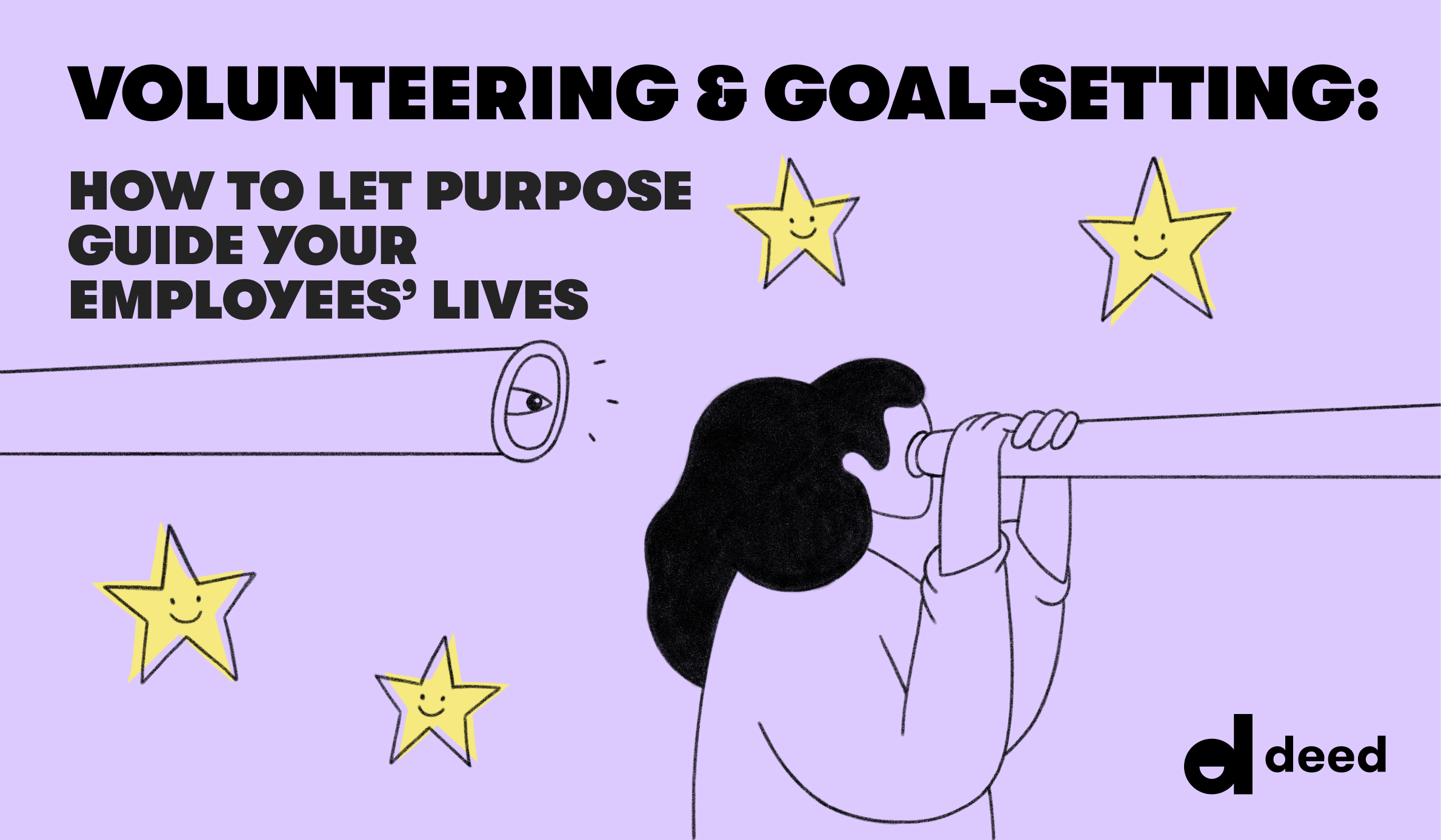Volunteering & Goal-Setting
How to let purpose guide your employees’ lives.
INTRODUCTION
New survey data from Gallup shows that at least seven in 10 Americans are likely to set some kind of goal this year. But with the list of ways we might improve our lives constantly expanding, many people don’t know when or how to start.
This is especially true in the workplace, where employees cannot help but search for the deeper meaning of everyday tasks as they hope to connect their work with a more fundamental sense of purpose. Employees often look to their managers for guidance here, as well as authentic encouragement to be themselves and follow their passions.
Volunteering is a fun and unique way that millions of people per year look for and often find a deeper sense of purpose in their lives by doing good deeds in their local communities. As employee volunteering and skills-sharing programs continue to grow, and the most useful social impact tech platforms redouble their focus on user experience, it’s clear that forward-looking managers are using new ideas and new tech at the same time to suffuse purpose throughout their teams’ daily lives.
In the process of setting this year’s goals for yourself and your team? Working to include your employees’ perspectives more often in your decision-making process? It’s important to think about what kinds of goals are available to you, and which ones are actually worth setting.
HOW DO I KNOW WHAT GOALS TO SET? (PLUS EXAMPLES)
Remember: Folks tend to set a wide range of goals, constantly adjusting them to suit changing perspectives and priorities. This is a good thing, but it does make it somewhat more challenging for managers to give their employees useful advice. From personal life to community involvement, here are some ways of thinking about goal-setting.
Health goals
Health comes first, full stop. There is always more to do to take better care of the body and mind. It’s especially important to be mindful of health as it relates to work. A recent survey from Microsoft shows that at least 48 percent of employees and 53 percent of managers are experiencing burnout, which frequently leads to anxiety, depression, and trouble controlling sleep and diet.
Too often, managers feel compelled to hold themselves to too high a standard of productivity and strength, when instead we could be sharing our experiences with our employees and building genuine community around nurturing our full selves. If our management style is defined by honesty, our employees will feel more comfortable sharing their honest thoughts and feelings in the workplace. Now is the time to set useful health goals.
Examples of health goals
- Get in touch with your general practitioner’s office to schedule your annual check-up early.
- Set a nightly reminder on all your devices for 30 minutes before your ideal bedtime.
- Commit to a weekly walk around your neighborhood.
- Visit an allergist to explore how your body interacts with your environment.
- Schedule an intake meeting for individual or group therapy. Already in therapy? Consider asking your therapist to discuss the strengths and limitations of their therapeutic method, and others you might try out together.
- Learn about the ways volunteering can improve your mental, physical, and social health.
Personal goals
When we talk about setting personal goals, we really have two aims in mind, and both relate to how we spend our time. First, there are productive activities, which are usually separate in nature from work-related tasks. Then there are restful activities—those crucial yet elusive periods reserved for winding down. A healthy balance of both kinds of personal goals is essential to feeling like we’re making the best use of our off-time.
Examples of personal goals:
- Cut screen time in half (at least).
- Read a debut book by an emerging writer.
- Sign up to volunteer with a nonprofit whose mission you care about and is active in your neighborhood.
- Develop an easy, affordable skincare routine.
- Take more time off from work, whether that’s paid time off (PTO) or volunteer time off (VTO).
- Hike an unfamiliar trail in your county or region.
Financial goals
This can be the year when money becomes less stressful to think about. Whether your employees are more interested in saving for the future or spending smartly in areas that really matter to them, the more concrete the goal, the more peace of mind they will feel.
Examples of financial goals:
- Make a list of all subscription services to make sure you’re only paying for what you really use.
- Pledge to donate a portion of your monthly or annual income to a cause you care about (and remember to save your receipt to take advantage of any possible tax savings).
- Reassess your credit card payment and interest rates to ensure they work for your budget.
- Revisit the details of your organization’s retirement plan and any contributions you may make to a retirement fund to make sure your short- and long-term needs are aligned.
- Create a file on your laptop for all W-2, 1099, and any other compensation-related forms and keep it on your homepage to remind you to file your taxes on time or even early.
- Consider purchasing pet insurance to help cover any unforeseeable expenses.
Career goals
As performance reviews are wrapped up, annual budgets are finalized, and the work year revs up to full speed again, the beginning of the year is an exciting time for employees to think about their career and where they want to focus the bulk of their time on the clock.
Examples of career goals:
- Schedule a meeting with colleagues to discuss your organization’s deeper purpose.
- Join or organize an employee resource group (ERG).
- Give your professional website and LinkedIn and Deed profiles a makeover.
- Collaborate with colleagues from other teams to “upskill” in an area you’re interested in.
- Volunteer to share your skills with a nonprofit in need.
- If you work remotely, spend a few hours at a local coffee shop.
Social life & community goals
Community is one of the deepest and most important sources of fulfillment and meaning. However, while people are well-versed in relationship goals—whether that means finding a partner or embracing single life—it’s somewhat more rare to see specific, concrete aims around social and communal life.
Examples of social life & community goals:
- Attend a local book club.
- Visit a friend or family member who lives out of town.
- Commit to spending time in your neighborhood park twice per month.
- Consider shifting your shopping habits to prioritize locally-owned businesses.
- Ramp up your civic engagement by attending a public meeting of your local government, such as your city council, state assembly, or state senate.
- Ask friends, neighbors, and/or family to join in volunteering with a local nonprofit.
WHY VOLUNTEERING HELPS US FEEL GROUNDED
Setting goals for the year is difficult if, like most people, your employees struggle to bridge the gap between their dreams for a meaningful life and their actual lived experience.
Taking a step back from the ebb and flow of normal life to do a simple good deed with friends and colleagues gives employees the chance to connect with a fundamental aspect of human existence. Namely, empathy. It’s much easier to do something good for someone in need when we can channel our genuine desire to do good into a specific activity on a specific day in a specific place.
Purpose-minded leaders know there’s only one real conclusion to draw from this data point: At least 63 percent of employees are looking to their managers and leaders for guidance incorporating purpose into their day-to-day lives.
The one conclusion? It’s time to expand access to meaningful activities like volunteering by working with social impact organizations and fun, engaging tech platforms employees actually want to spend time using.
WHERE TO LOOK FOR VOLUNTEER OPPORTUNITIES IN DAY-TO-DAY LIFE
While the COVID-19 pandemic temporarily sent most volunteers to their phones and laptops (except, of course, those providing crucial, frontline services), the data shows that in-person events came roaring back in 2022. At Deed alone, 93 percent of all volunteer events on our platform this year happened face-to-face.
That said, virtual events are undoubtedly here to stay. Not only do they help large organizations with employees scattered across the globe to do good deeds together, they also dramatically expand accessibility to hybrid/remote workers and those with health-related limitations on physical activity.
The takeaway? In order to set achievable goals in the new year, it’s important to make sure that the nonprofit partnerships, social impact programs, cause campaigns, and volunteer events you are running truly match your employees’ abilities and expectations. The first order of business is to identify nonprofits that are a true mission match for your organization. Then, take every precaution to ensure your programs are as accessible as possible. Finally—and this one is important—always keep an open mind to new partnerships, new technologies, and new ideas around how to make good on your organization’s commitment to its core purpose.
LET PURPOSE GUIDE YOUR EMPLOYEES’ LIVES IN 2023
To help your employees set goals that will genuinely improve their lives, purpose-oriented organizations cannot go without a tech platform that helps people find causes and organizations they truly believe in.
Deed is a workplace volunteering and giving platform that puts people first, because user experience shouldn’t stand between you and doing good. We foster genuine human connection across departments and time zones by empowering employees to support causes they care about together, both in-person and online. We help social impact and diversity, equity, inclusion, and belonging (DEIB) teams alike to centralize all their programming, from emergency fundraisers to fun volunteering events, and engage diverse employee resource groups.
We believe everyone’s passion can be met; Deed showcases over two million nonprofits and counting. Our vast payment infrastructure is backed by trusted names like PayPal, who securely process billions in donations per year—to help you give with ease and confidence.
Now imagine all your community’s good deeds happening on a single, exceptionally designed platform—with you at the switchboard, watching an enterprise transform into a more positive force in the world.


